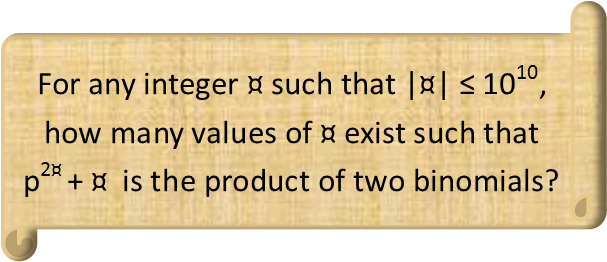Math Made Easy: Problem of the Day 66

This is one of the simpler problems Iíve covered. It requires no to very little computation Ė just recognition of five math facts will help you solve it.
The very first thing is to not get all flustered over that funky symbol §. Letís call it Bob. Really, itís just serving as a variable. I intentionally chose a silly symbol to illustrate a point Ė many people, when they encounter something in math that *looks* unfamiliar, decide that it *is* unfamiliar. They spend so much time focusing on the strangeness of it, they donít see the forest for the trees. And because of that, they decide that somehow, math must magically be working differently in the problem theyíre encountering. Well, since Bob is described as ďany integer,Ē itís just a variable, and the math works just the same.
Next, we look at the conditions that Bob must meet. Its absolute value must be less than, or equal to, 1010. This doesnít eliminate a whole lot. Bob could be positive, negative, or zero.
Thirdly, we know that Bob cannot be zero. We know this because it is part of the product of two binomials. For § to be zero, the constant in both binomials would be zero, and they would no longer be binomials, but rather monomials.
Fourth, we see Bob is a product. Specifically heís the constant that arises when two binomials multiply, and give a binomial of even degree. The only way this can happen is for a difference of squares. This means each binomial has the same constant, but with a different sign. For instance, (x Ė 2)(x + 2) is a difference of squares. Differences of squares always produce a constant with a negative sign. Therefor Bob is negative.
Finally, because Bob is the constant in the product of a difference of squares, |§| must be a perfect square. So we can find how many Bobs can possible exist between 0 and -1010 (negative because § is negative). To do this, we simply take the square root of 1010. That tells us how many numbers square to give something less than or equal to 1010.
We can easily take the square root of any exponential by simply dividing the exponent by two (or multiplying it by ½). That means that there are 105 perfect squares that are between 0 and -1010. So there are 105 potential values for §.
This problem was solved almost entirely with deductive reasoning. We only had to make one little calculation at the end, and it was a very simple one. The whole point of the exercise was this: donít get flustered by seemingly unfamiliar things in your math. Examine the entirety of the problem, and try to determine if it is something with which you actually are familiar, just presented in a way to which youíre not accustomed. Perhaps it is something a little new, but the rest of the math is old hat. This will help you tackle it, and achieve your desired outcome.
|



